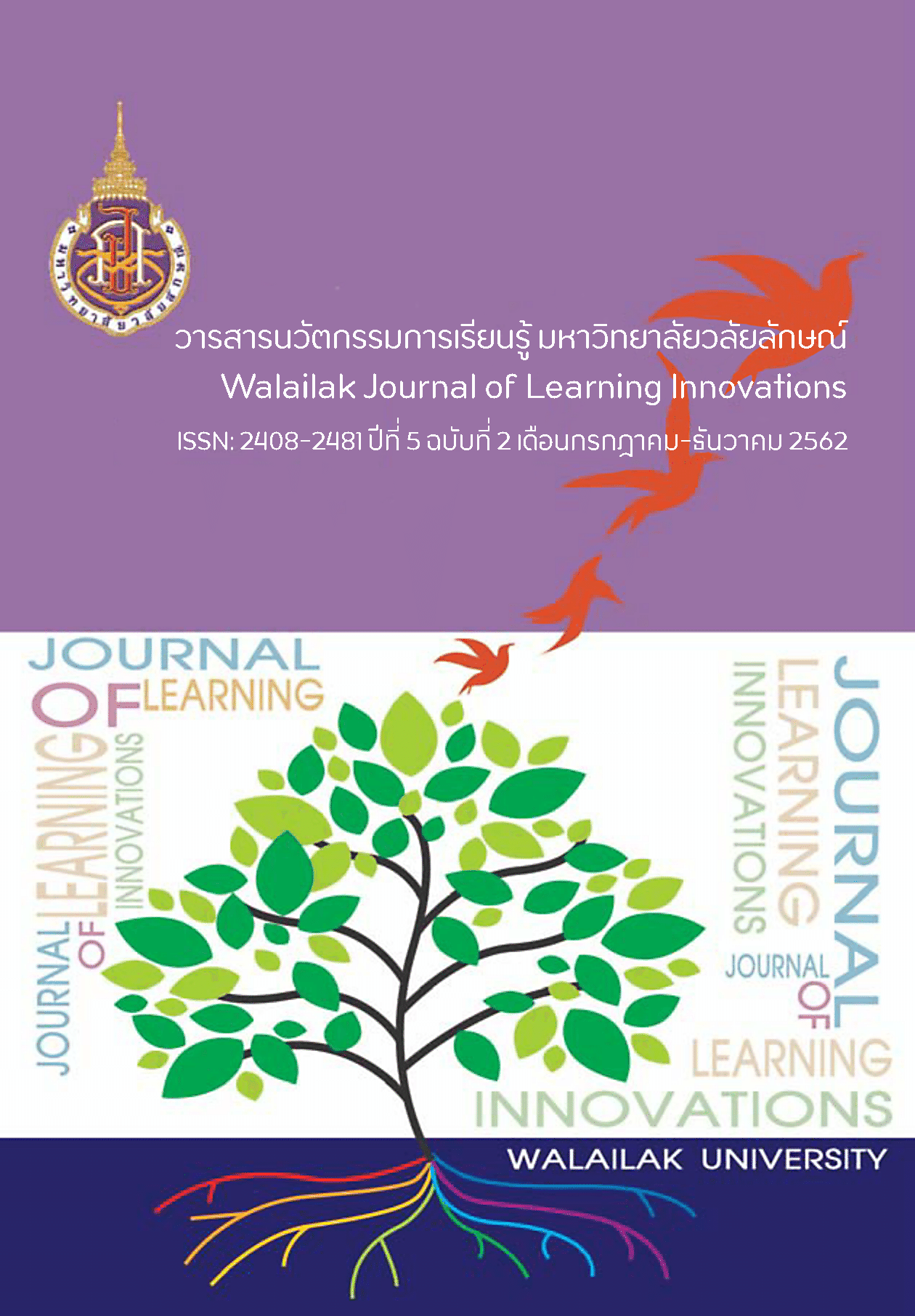Digital Literacy of Undergraduate Students at Walailak University.
DOI:
https://doi.org/10.14456/jli.2019.8Keywords:
Digital Literacy, Information Technology, Computer usage behaviour, Walailak UniversityAbstract
The purposes of this research are to 1) evaluate the digital literacy results of undergraduate students at Walailak University classified by programme, branch, and faculty of students; 2) analyze factors related to the results of the digital literacy test; 3) analyze the relationship of the digital literacy level and learning achievement; and 4) study the obstacles and suggestions for learning management regarding digital technology for those involved. The sample group consisted of 1,220 first-year students and used the testing scores for digital technology with the questionnaire on computer usage behaviour. The percentage, mean, chi-square value, and correlation statistics were calculated. The results show that 73.77% of the subjects passed the exam with a score of more 50%. Of those who passed the examination, according to the score range, most had low digital literacy with a score of 50% to 54% (30.92%), followed by a score of 55% to 59% (27.92%). The relationship analysis of the computer usage behaviors related to the exam results found that the related factors include the following (with a statistical significance at the level of 0.05): the student program, faculty, grade point average of the user in computer subjects, number of hours of computer usage per day, and activities performed using computers. In addition, the level of digital knowledge of the learner was related to the average grade of the learner in a positive direction (r = 0.393; with statistical significance at the 0.01 level). Suggestions for students to improve their digital literacy knowledge include supplementary training (60.78%) and online learning systems (24.43%). The main obstacle to improve digital knowledge is Internet inefficiency (76.70%) and Internet unavailability (74.78%).
References
https://www.researchgate.net/publication/277651580_An_overview_of_the_world_of_MOOCs
ILDC Thailand. (2017). Digital Literacy Project. Retrieved 6 July 2018, from https://www.icdlthailand.org/dl.
Karpati, A. (2011). Digital literacy in education. Retrieved 5 February 2018, from https://iite.unesco.org/pics/publications/en/files/3214688.pdf.
Leenaraj, P. (2017). Digital lLiteracy skill for developing learning quality. T.L.A. Bulletin. 61(2), 76-92.
MediaSmarts. (2017). Digital Literacy Fundamentals. Retrieved 5 February 2018from https://mediasmarts.ca/digital-media-literacy-fundamentals/digital-literacy-fundamentals.
Ministry of Information and Communication Technology. (2016). Digital Economy Plan. Retrieved 6 July 2018, from https://www.ega.or.th/upload/download/file_9fa5ae40143e13a659403388d226efd8.pdf
National Science and Technology Development Agency. (2015). Digital literacy. Retrieved 10 January 2018, from https://www.nstda.or.th/th/nstda-knowledge/142-knowledges/2632.
Saechan, T. & Morsorn, T. (2016). Digital Literacy : Definition, Component and Current Situation. Journal of Information Science, 34(4), 116-145.
Techataweewan, W. & Prasertsin, U. (2016). Digital Literacy Assessment of the Undergraduate Students of the Universities in Bangkok and Its Vicinity. Journal of Information Science, 34(4), 1-28.
Ting, Y. L. (2015). Tapping into Students’ Digital Literacy and Designing Negotiated Learning to Promote Learner Autonomy. Internet and Higher Education, 26, 25-32.
Wongya, N. (2018). A Guide to Developing Digital Literacy Skills of Digital Native. Veridian E-Journal, Silpakorn University, 10(2), 1630-1642.
Downloads
Published
How to Cite
Issue
Section
License
เนื้อหาและข้อมูลในบทความที่ลงตีพิมพ์ในวารสารนวัตกรรมการเรียนรู้ มหาวิทยาลัยวลัยลักษณ์ ถือเป็นข้อคิดเห็นและความรับผิดชอบของผู้เขียนบทความโดยตรง ซึ่งกองบรรณาธิการวารสาร ไม่จำเป็นต้องเห็นด้วย หรือร่วมรับผิดชอบใดๆ
บทความ ข้อมูล เนื้อหา รูปภาพ ฯลฯ ที่ได้รับการตีพิมพ์ในวารสารนวัตกรรมการเรียนรู้ มหาวิทยาลัยวลัยลักษณ์ ถือเป็นลิขสิทธิ์ของวารสารนวัตกรรมการเรียนรุ้ มหาวิทยาลัยวลัยลักษณ์ หากบุคคลหรือหน่วยงานใดต้องการนำทั้งหมดหรือส่วนหนึ่งส่วนใดไปเผยแพร่ต่อเพื่อกระทำการใดๆ จ้อต้องได้รับอนุญาตเป็นลายลักษณ์อักษรจากวารสารนวัตกรรมการเรียนรู้ มหาวิทยาลัยวลัยลักษณ์ก่อนเท่านั้น


